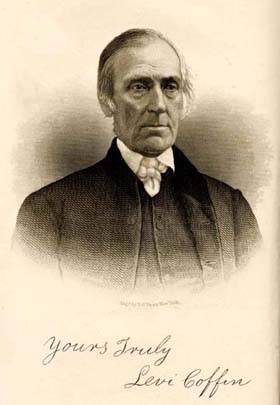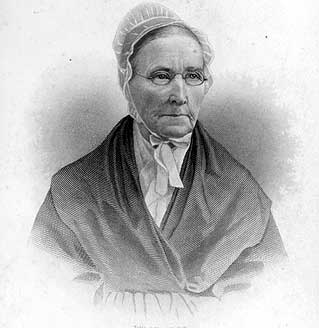Coffin, Levi
28 Oct. 1798–16 Sept. 1877
 Levi Coffin, abolitionist, temperance leader, and philanthropist, was born in New Garden, Guilford County, a descendant of Tristam Coffin, who came to America in 1642 and was one of nine purchasers of Nantucket from the Indians. Only son and seventh child of Levi and Prudence Williams Coffin, whose families had removed from Nantucket to New Garden before the American Revolution, Levi was taught largely by his father in their pioneer home. At twenty-one he studied briefly in some unknown school, and thereafter he taught and studied alternately for several years. In spite of the opposition of the elders, he joined the young Quakers of New Garden in 1818 in establishing a Sunday school in the new brick school adjoining the meeting house. This endeavor met with such success that he assisted in organizing other Sunday schools wherever he went. At about this time he joined the first manumission society in Guilford County, remaining an active member throughout its existence. In 1821 he and his cousin, Vestal Coffin, organized a school for slaves; there, on Sunday afternoons, with permission of the masters, they taught the elements of Christianity and reading of the Bible. The slaves were so interested that some of the masters became opposed, and the school was forbidden.
Levi Coffin, abolitionist, temperance leader, and philanthropist, was born in New Garden, Guilford County, a descendant of Tristam Coffin, who came to America in 1642 and was one of nine purchasers of Nantucket from the Indians. Only son and seventh child of Levi and Prudence Williams Coffin, whose families had removed from Nantucket to New Garden before the American Revolution, Levi was taught largely by his father in their pioneer home. At twenty-one he studied briefly in some unknown school, and thereafter he taught and studied alternately for several years. In spite of the opposition of the elders, he joined the young Quakers of New Garden in 1818 in establishing a Sunday school in the new brick school adjoining the meeting house. This endeavor met with such success that he assisted in organizing other Sunday schools wherever he went. At about this time he joined the first manumission society in Guilford County, remaining an active member throughout its existence. In 1821 he and his cousin, Vestal Coffin, organized a school for slaves; there, on Sunday afternoons, with permission of the masters, they taught the elements of Christianity and reading of the Bible. The slaves were so interested that some of the masters became opposed, and the school was forbidden.
On 28 Oct. 1824, Coffin married Catherine White at Hopewell Church, Guilford County. In 1826 they moved to Newport (now Fountain City), Wayne County, Ind., where they opened a store. Finding themselves on a route along which escaped slaves passed to free territory, they joined the movement known as the Underground Railroad, helping to shelter such people and arrange transportation to Canada and elsewhere. Maintaining two teams, Coffin journeyed at  night over secret roads, carrying fugitives to hiding places from which others carried them on to safety. Among those so rescued from slavery was a nameless woman who carried her infant across the broken ice of the Ohio River while pursued by bloodhounds, eventually reaching the Coffin home. She was described as Eliza Harris in the Harriet Beecher Stowe novel Uncle Tom's Cabin, and the phrase "Eliza crossing the ice" became a synonym for a narrow escape.
night over secret roads, carrying fugitives to hiding places from which others carried them on to safety. Among those so rescued from slavery was a nameless woman who carried her infant across the broken ice of the Ohio River while pursued by bloodhounds, eventually reaching the Coffin home. She was described as Eliza Harris in the Harriet Beecher Stowe novel Uncle Tom's Cabin, and the phrase "Eliza crossing the ice" became a synonym for a narrow escape.
Coffin, known as president of the Underground Railroad, was a member of the Committee on Concerns of People of Color to Consider Their Education and was treasurer of funds to aid the poor and destitute. He was also active in the temperance movement. Feeling it wrong to use goods made by slave labor, he removed to Cincinnati, Ohio, in 1847, where for five years he operated a wholesale store selling products of free labor. He began work for the freedmen at the outbreak of the Civil War and devoted the rest of his life to that cause. In May 1864 he went to the British Isles; there he was instrumental in organizing the English Freedmen's Aid Society, which sent over one hundred thousand dollars in money and supplies to America in a single year. He was delegate to the International Anti-Slavery Society in Paris in 1867. The last years of his life he spent in writing his autobiography, Reminiscences of Levi Coffin, published in 1876 by the Western Tract Society of Cincinnati, Ohio.
References:
Cincinnati Enquirer, 18 Sept. 1878.
Laura Haviland, A Woman's Life Work (1882).
Historical Magazine 14 (Sept. 1868).
New England Historical and Genealogical Register 2 (Oct. 1848).
Quaker Collection (Guilford College Library, Greensboro).
W. H. Seibert, Underground Railroad from Slavery to Freedom (1898).
Stephen B. Weeks, Southern Quakers and Slavery (1896).
Additional Resources:
Levi Coffin Home, Indiana State University: http://www.indianamuseum.org/explore/levi-coffin-house
Coffin, Levi. 1880. Reminiscences of Levi Coffin, the reputed president of the Underground Railroad... Cincinnati: Robert Clark & Co. https://docsouth.unc.edu/nc/coffin/menu.html
Dannheisser, Ralph. 2008. "Quakers played major role in ending slavery in United States" U.S. Dept. of State
Resources on slavery and Quakers in libraries [via WorldCat]
This will of Levi Coffin, University of Cincinnati: http://www.libraries.uc.edu/content/dam/libraries/arb/docs/wills/coffin-will.pdf
Levi Coffin, National Park Service: https://www.nps.gov/resources/person.htm?id=68
Levi Coffin House: https://www.nps.gov/nr/travel/underground/in2.htm
"N.C. Manumission Society." N.C. Highway Historical Marker J-103, N.C. Office of Archives & History. https://www.ncdcr.gov/about/history/division-historical-resources/nc-highway-historical-marker-program/Markers.aspx?sp=Markers&k=Markers&sv=J-103 (accessed May 15, 2013).
Image Credits:
Levi Coffin, from Coffin, Levi. 1880. Reminiscences of Levi Coffin, the reputed president of the Underground Railroad... Cincinnati: Robert Clark & Co. https://docsouth.unc.edu/nc/coffin/frontis1.html
Catherine Coffin, University of Cincinnati: http://www.libraries.uc.edu/libraries/arb/exhibits/soaweek2006/TheWillofLeviCoffin.html
1 January 1979 | Hoskins, Mary Katherine